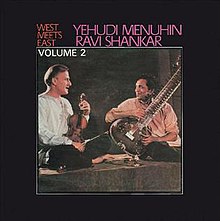| West Meets East, Volume 2 | ||||
|---|---|---|---|---|
 | ||||
| Studio album by | ||||
| Released | 15 July 1968 | |||
| Recorded | 1967–68 Angel Records, New York City | |||
| Genre | Indian classical | |||
| Length | 1:03:34 | |||
| Label | HMV, Angel | |||
| Yehudi Menuhin and Ravi Shankar chronology | ||||
| ||||
| Review scores | |
|---|---|
| Source | Rating |
| AllMusic | |
West Meets East, Volume 2 is an album by American violinist Yehudi Menuhin and Indian sitar virtuoso Ravi Shankar, released in 1968. It is the second album in a trilogy of collaborations between the two artists,[2] after the Grammy Award-winning West Meets East (1967).[3]
The release followed Menuhin and Shankar's duet on 10 December 1967 at the United Nations in New York, celebrating the twentieth anniversary of the Universal Declaration of Human Rights.[4] As part of his utopian ideal,[5] international human rights was a cause long supported by Menuhin in his work,[6] while for Indian classical music, this Human Rights Day recital marked the first time that a performance had received a worldwide television broadcast.[7]
Reflecting the celebrity status afforded the sitarist during this period, particularly as a result of his association with George Harrison of the Beatles,[8][9] Shankar's activities were filmed for a documentary on his life, released as Raga in 1971,[10] and his autobiography My Music, My Life (1968) became a bestseller.[11] Although West Meets East, Volume 2 was another popular success for Menuhin and Shankar,[12] their work together drew further criticism from purists in India,[13] who considered that Shankar was westernising and thus diluting Indian classical music.[14]
Recording and musical content
[edit]The follow-up to West Meets East was announced in February 1968, when Billboard magazine reported that Menuhin and Shankar had been recording new material together at Angel Records' New York studios.[15] While their first album continued to top that magazine's Best Selling Classical LP's listings,[16] Shankar had also achieved mainstream success with the recently released Live: Ravi Shankar at the Monterey International Pop Festival, which peaked at number 43 on the Billboard Top LP's chart – the highest US chart placing he would achieve throughout his career.[17] Angel released the new Menuhin–Shankar set on 15 July that year.[18] The album peaked at number 3 on the Classical LP's listings.[19]
West Meets East, Volume 2 contains a version of the piece played at the United Nations, an interpretation of Raga Piloo.[2] According to Shankar's comments in a March 1968 issue of Rolling Stone magazine, they recorded this selection "just a few days ago".[20] As at the recital,[21] Menuhin and Shankar were accompanied by Alla Rakha on tabla and Kamala Chakravarty, Shankar's female companion,[22] on tambura.[23] The second piece is "Raga Ananda Bhairava", performed by Shankar with his regular accompanist and instrument-maker, Nodu Mullick,[24] on tambura, and Rakha again on tabla.[23]
Side two in the original LP format consists of Menuhin and his sister Hephzibah performing Bartók's Sonata No. 1 for Violin and Piano.[23]
Track listing
[edit]All selections by Ravi Shankar except where noted.
Side one
- "Raga Piloo" – 14:44
- "Raga Ananda Bhairava" – 15:37
Side two
- "Sonata for Violin & Piano No. 1" (Béla Bartók) – 33:13
Personnel
[edit]- Yehudi Menuhin – violin
- Ravi Shankar – sitar
- Alla Rakha – tabla
- Hephzibah Menuhin – piano
- N.C. Mullick – tambura
- Kamala Chakravarty – tambura
See also
[edit]References
[edit]- ^ "Yehudi Menuhin and Ravi Shankar West Meets East, Vol. 2", AllMusic (retrieved 3 December 2013).
- ^ a b Lavazzoli, p. 63.
- ^ Reginald Massey, "Ravi Shankar obituary", The Guardian, 12 December 2012 (retrieved 3 December 2013).
- ^ Shankar, Raga Mala, p. 184.
- ^ Allan Kozinn, "Sir Yehudi Menuhin, Violinist, Conductor and Supporter of Charities, Is Dead at 82", New York Times, 13 March 1999 (retrieved 4 December 2013).
- ^ "12 March 1999: Violinist Yehudi Menuhin dies", BBC News Online (retrieved 4 December 2013).
- ^ Lavezzoli, pp. 7–8, 63.
- ^ World Music: The Rough Guide, pp. 109–10.
- ^ Shankar, My Music, My Life, pp. 101–03.
- ^ Lavezzoli, pp. 184, 187.
- ^ Massey, p. 142.
- ^ World Music: The Rough Guide, p. 109.
- ^ Lavezzoli, p. 146.
- ^ Shankar, Raga Mala, pp. 208–09.
- ^ "Classical Music". Billboard. 3 February 1968. p. 43. Retrieved 23 August 2015.
- ^ Kirby, Fred (13 January 1968). "Mahler Takes Listings Crown From Beethoven". Billboard. p. 34. Retrieved 23 August 2015.
- ^ Gallo, Phil (12 December 2012). "Ravi Shankar's Impact on Pop Music: An Appreciation". billboard.com. Retrieved 22 August 2015.
- ^ Staff writer (13 July 1968). "Angel's Follow LP on 'West'". Billboard. p. 30. Retrieved 24 August 2015.
- ^ "Billboard Best Selling Classical LP's". Billboard. 28 September 1968. p. 29. Retrieved 24 August 2015.
- ^ Sue C. Clark, "Ravi Shankar: The Rolling Stone Interview", Rolling Stone, 9 March 1968 (retrieved 3 December 2013).
- ^ Shankar, My Music, My Life, p. 96.
- ^ Shankar, Raga Mala, pp. 157, 196.
- ^ a b c Sleeve credits, West Meets East, Volume 2 LP (HMV Records, 1968).
- ^ Shankar, Raga Mala, p. 159.
Sources
[edit]- Peter Lavezzoli, The Dawn of Indian Music in the West, Continuum (New York, NY, 2006; ISBN 0-8264-2819-3).
- Reginald Massey, The Music of India, Abhinav Publications (New Delhi, NCT, 1996; ISBN 81-7017-332-9).
- Ravi Shankar, My Music, My Life, Mandala Publishing (San Rafael, CA, 2007; ISBN 978-1-60109-005-8).
- Ravi Shankar, Raga Mala: The Autobiography of Ravi Shankar, Welcome Rain (New York, NY, 1999; ISBN 1-56649-104-5).
- World Music: The Rough Guide (Volume 2: Latin and North America, Caribbean, India, Asia and Pacific), Rough Guides/Penguin (London, 2000; ISBN 1-85828-636-0).